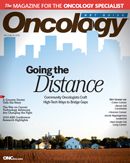Publication
Article
Oncology Live®
Bolder Cigarette Labels in the Works
Author(s):
The ravages of lung cancer due to cigarette smoking are all too familiar to oncology healthcare providers.

The ravages of lung cancer due to cigarette smoking are all too familiar to oncology healthcare providers. Would showing consumers some of the same brutal realities of the disease convince them not to buy cigarettes?
The FDA is aiming to find out with a series of bracing images under consideration for cigarette packages that marks the first effort to update the label warnings in more than 25 years. In November, the agency unveiled 36 images grouped into 9 categories reflecting the warnings required for the cigarette packs.
The proposed images include a depiction of a person with broken, yellowed teeth; a drawing of an emaciated patient with ghostly gray skin lying in a hospital bed; and an image of a mother blowing smoke into her baby’s face.
With the new labels, the FDA is taking “a crucial step toward reducing the tremendous toll of illness and death caused by tobacco use by proposing to dramatically change how cigarette packages and advertising look in this country,” FDA Commissioner Margaret A. Hamburg, MD, said in a press release announcing the new images. “When the rule takes effect, the health consequences of smoking will be obvious every time someone picks up a pack of cigarettes.”
The agency is asking the public to comment on the proposed labels through Tuesday, January 11. The FDA has until mid-June to select 9 images that will be paired with the warning text on a rotating basis. By fall 2012, the new health warning text and images are required to be included on all cigarette packages.
The updated warnings are required under the Family Smoking Prevention and Tobacco Control Act enacted in 2009. The law mandates 9 larger and more striking warning statements with color graphic images portraying the health consequences of smoking, the FDA said. The warnings are supposed to cover the top 50% of the front and rear panels on every cigarette pack and comprise at least 20% of every cigarette advertisement.
The 9 warning statements already are determined: cigarettes are addictive; tobacco smoke can harm your children; cigarettes cause fatal lung disease; cigarettes cause cancer; cigarettes cause strokes and heart disease; smoking during pregnancy can harm your baby; smoking can kill you; tobacco smoke causes fatal lung disease in nonsmokers; and quitting smoking now greatly reduces serious risks to your health.
Although the label changes are shaping up as a result of the recent law, federal offi cials say they also are part of a wider government attack on cigarette smoking that includes more support for cessation programs, more aggressive enforcement of illegal tobacco sales to minors, and a 62-cent increase in the federal cigarette tax to more than $1.
More Info» http://tinyurl.com/3ag7an8




















%20(2)%201-Recovered-Recovered-Recovered-Recovered-Recovered-Recovered-Recovered-Recovered-Recovered-Recovered-Recovered-Recovered-Recovered-Recovered-Recovered-Recovered-Recovered.jpg?fit=crop&auto=format)